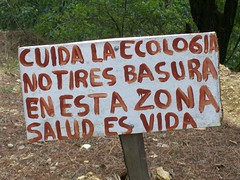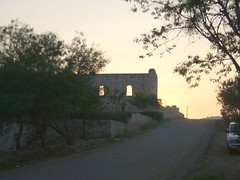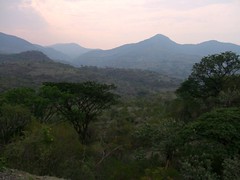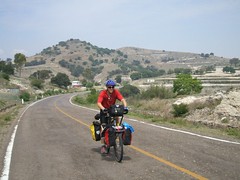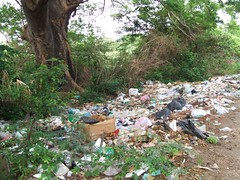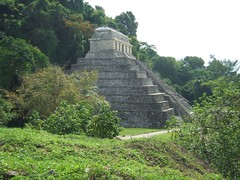Inuvik to Ushuaia
Mexican Billboards
A Very Organized Community
We saw clean highways, trash receptacles everywhere, and signs reminding everyone of their civic duty. This sign says "Take care of nature - don't throw trash. Health is LIfe." I can tell you we've seen some very trashed communities and highways at times in Mexico, and it was so amazing that this region had taken it in mind to put an end to this.
They also told us they have a community highway trash pickup every two months! We were impressed.
A Quiet Day's Ride In the Oaxacan Mountains
The early morning is a great time to ride because of the muted morning colors that fill the surrounding landscape, This morning was especially wonderful because the red-colored soil that stretched all around us was lit up doubly with the rising morning sun. A mist hung above the rich farm lands as we rode the quite river valley road. This moment of bliss was interrupted as the awakening sun heating the morning mist and us with it.
At 10 miles out we stopped for breakfast of quesadillas and sandwiches called tortas. As we waited for breakfast, I adjusted my seat for today’s ride. Yesterday's ride of 4500 feet climb stressed my soft tissue so an adjustment was called for.
We rode almost all day along a ridge line, deep valleys to the left and massive valleys to the right. We would climb 500 feet and descend 400 feet, and repeat this over and over. Climbing and descending. All and all we climbed over 3600 feet for the days total. I was in awe, how a road can be built along a ridge for 40 miles and have view on the left and right. It was an incredible bike ride with the beautiful vistas of tropical Oaxacan plants scattered throughout the expansive terracotta-colored landscape, but at the same time it is the dry season, and the land waits patiently for the rain to come in earnest.
As I rode the long miles, I kept myself entertained by looking around at the sights which are so foreign to me yet spike my curiosity. Who lives in the Adobe brick houses with tin roofs which stood on every distant hill top? What was life like for lone Mixtec Indian who worked hunched over his plot of land, and woman hunched over the concrete basins washing the endless piles of clothes, or preparing the days food? Why was the goats and mules making those awful sounds of protest? I let my mind wander for most of the time except when traffic approached or the road side DOG gave chase to me in which I focus on patterns of approach and the need for evasive action. Cars are mostly predictable, but not always. If I see a single car, it can go around me. If there are a bunch of big vehicles such as buses or large trucks, I avoid them and get off the road.
Highways and Traffic and Bicycling in Mexico
First of all, our biggest risk here is the same as the biggest risk has been from Canada on down. It's getting wiped out by traffic. We're out there on the side of the road every day and we're vulnerable. One sleepy driver can swerve to the right just a little bit and we're history. We know it happens, and so do you. We have two main strategies here. We try to find the less-traveled roads using the best maps and information we can come up with, and we use mirrors on our helmets.
Security and Safety in Mexico
We've told you about the highways and our greatest risk in every country - the traffic. But many of you were most worried that we'd be abducted by drug-traffickers or thrown in prison by the "federales." And some have asked us why we weren't bringing a gun (Don't bring a gun to Mexico! You'll go straight to jail if it's discovered at a border crossing!).
In terms of our everyday experience, we have to tell you that Mexico seems to be the safest country we've traveled in on our trip so far. Our perceived level of risk both to person and property is lower than in either Canada or the United States. Nobody has bothered us or our stuff in any way.
Now we'll have to admit that we're not careless travelers and we keep our eyes on our things and don't leave our bikes unattended. We're experienced third-world travelers. And if somebody says an area is dangerous, we listen carefully and try to evaluate the risks. And we also have to admit that we aren't likely to be seen as good kidnapping subjects, since there's nobody to ask for a ransom. Most people here think our bikes are pretty cool, and pretty expensive by Mexican standards, but they don't seem to think we have all that much money (or we'd be going by car, right?) So maybe our risk level is lower because we're a small target. But I don't think so. I think Mexico is just a mighty calm, friendly place.
The other day I read the US State Department's advisory about Mexico. It could get you *really* scared! read more here... lee mas aquí... »
Things We Don't Like About Mexico
- The trash on the roads and even around the towns is abominable in places. ABOMINABLE. Unbelievable. I don't know what's wrong with Mexico and trash, but they need to get it straightened out. We have seen entire little villages strewn with plastic bags and bottles. One that I saw looked like a dump until I looked closer and realized there were houses. We rode along a canal the other day near the coast and found dumped plastic garbage bags everywhere for miles, with dogs digging into bags containing animal entrails and endless piles of plastic trash. There was even a dead pig rotting in the swampy water along the roadside gutter.
Mexican Earnings - Wages and Salaries
Every so often I ask people what wages they make in their work. Here are some examples:
- A Hammock weaver and salesman on the coast nets about $20/day on a good day when his wife is weaving and he's selling to motorists at a military checkpoint.
- Policemen make an average of $16/day nationwide, reaching up to $20 in some of the better-paying states, but going even lower than that in many places. It's quite a concern in the country because with salaries that low, it can be very cheap for a narco-trafficker to buy off a policeman.
- Taxi Drivers in Tuxtla Gutierrez, if they own their own taxi, can net $40-$50/day by working 12-16 hours.
- Teachers can make about $600/month, or $25/day and many have to work far from home and family, coming home a few times during a month.
We don't like to think about this, but when we go out to dinner and spend $10, or stay in an inexpensive (to us) hotel for $20, we're dropping more than most people's daily income just on that item. And, as we'll find farther south, Mexico is fairly well-off compared to much of Latin America.
Narco-Traffickers in Mexico
Our entire experience of Mexico has been of a very tranquil country, with wonderful people. We haven't had to worry about our safety anywhere (except on the roads, of course, and you've already read about our safety situation on the road, or will below). It doesn't feel like we have to do much at all to keep our stuff safe, and we've had absolutely no issues with our personal safety; knock on wood.
That said, we also read the newspapers. And Mexico is in big trouble with its/our narco-trafficking problem (since the US is the primary consumer, it's a problem shared by both the US and Mexico). Big trouble. Even when you factor in that the media is fascinated with the subject and maybe they've overblown it, you still have daily assassinations of policemen, more than 1000 in the country so far this year. It seems that every day somewhere in the country a dismembered human head will be delivered to a police station with a "narcomessage" threat. Observers think that some parts of the police are clearly compromised by the drug traffickers. And reporters (print and media) are also being targeted at a rate almost as high as anywhere in the world. (Remember that all our information is coming from the newspapers. read more here... lee mas aquí... »
Mexico Map and GPS Resources for the touring cyclist
If you're seeking the back roads of Mexico, you need good maps.
All of our routes are shown on the hobobiker under routes - we have maps and the distance and elevation information. The Mexico routes and info are here and if you need anything else we can give you we'll certainly try to provide it. Send us a note.
We delighted in two geographic resources for Mexico.
- The Guia Roji "Por las carreteras de Mexico" available from Amazon.com and in bookstores and the like in every major Mexican city. It is up-to-date and has excellent detail. We just ripped out the pages we didn't need.
- In our Garmin GPS we used the excellent Bicimapas GPSmap available from Mexicomaps.com. It wasn't perfect and in some cases missed new roads, but it showed some amazingly good detail.


